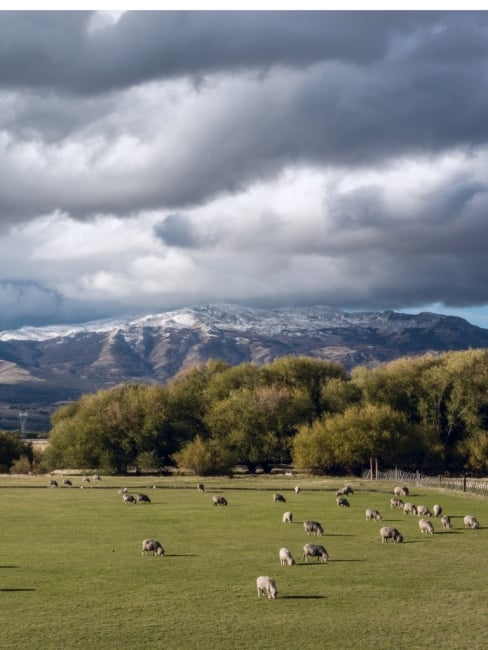You have /5 articles left.
Sign up for a free account or log in.

Chubut region of Patagonia
Istock.com/xeni4ka
Students who are considering in a career in the humanities face a significant hurdle today in their pathways to those fields. For many interested students, their only exposure to humanities disciplines is through coursework or an independent study, typically in the confines of a mentor’s office. While enriching, such experiences do not always expose students to the full range of possibilities within humanistic research.
A large-scale, collaborative project, however, gives students the chance to see cross-disciplinary faculty dynamics in action and demonstrates firsthand the important role humanities can play in our society.
We discovered that ourselves when we designed the University of Michigan project “From Africa to Patagonia: Voices of Displacement,” funded by the Humanities Collaboratory, to encourage collaborative, multigenerational humanities scholarship. Involving more than 40 team members -- eight faculty members and three dozen undergraduate and graduate students from the United States and abroad -- it has been a transformative experience over the past three years for everyone involved. While the pandemic has added new challenges, we believe this type of project remains not only feasible but also has the power to reimagine undergraduate education in the humanities.
The project originated when linguist Andries Coetzee, an Afrikaans-speaking South African native, met with Spanish linguists Lorenzo García-Amaya and Nicholas Henriksen at the University of Michigan about the Patagonian Boers, who had achieved an almost mythical status in his native country. This little-known Afrikaans-speaking community, descended from South African immigrants, has been living in the Chubut province of Patagonia for the last century. The Patagonian Boers speak a form of Afrikaans with innovative grammatical features not heard in South Africa for generations.
The three linguistics professors embarked on a research trip to Argentina in 2014, where they recognized that, for many people in the community, language was tied to a sense of identity. That identity encompassed personal histories and relationships with the past, and it remained an integral part of the community’s sense of self in the present. Even though linguists are often trained in interdisciplinary ways, it was impossible to encapsulate the cultural context of the community’s language use through a unidimensional phonetic study. Coetzee, García-Amaya and Henriksen all agreed that a substantially broadened, interdisciplinary collaboration was essential. After receiving a grant from the Michigan Humanities Collaboratory in the spring of 2017, the Argentine-Afrikaans Collaboratory team was formed.
Colleagues holding a variety of appointments at the University of Michigan across as many as seven different administrative units have been involved. As a consequence of our varied backgrounds, we have developed a combination of ethnographic, linguistic and historiographical methods in order to accurately and thoroughly explore the voices and ideologies of the remaining South African descendants in Chubut. The data that faculty members and students have collected during several fieldwork trips have offered us extensive opportunities for rigorous intellectual exploration and analysis of the language use of the Argentinian Boers. And our graduate and undergraduate students have brought a variety of perspectives from their respective areas of study that have been vital to our progress.
Our collaboration faced its biggest challenge when, within days, our campus was required to adapt to the COVID-19 pandemic by operating virtually. Fortunately, as we were already accustomed to communication with collaborators across the globe, we found that the transition to remote work required only a small adjustment. Besides facilitating greater ease of communication, our model has proved to be flexible and adaptive, with members worldwide able to contribute to various aspects of our endeavor despite adhering to physical distancing. Although we recognize that, for the near future, participants in this type of collaboration will probably not be able to conduct fieldwork trips as easily as we did, many of the core principles outlined here remain applicable to any collaboration. Even more important, however, are stories from our undergraduate researchers, proving that continuing in our shared mission provided stability and a sense of normalcy as the world around them changed rapidly.
Of course, projects of this scope bring with them other complications and challenges. Some of those we’ve had to overcome include the following.
Harnessing collective wisdom: working as a team. The first challenge was to pool our individual strengths in an interdisciplinary environment. The questions that our team initially set out to ask, and the ways we asked them, changed substantially over the course of the project. They evolved as we worked along and outside the borders of our bodies of expertise and discovered new paths of research.
We seized the opportunity to discover new ways of delineating and evaluating elusive elements of the human experience such as identity and memory, thereby posing questions that would have been impossible to consider on an individual level. By co-creating our questions and methodologies, we were able to gather a new kind of data: a rich corpus of sociological interviews that none of us could have previously imagined possible.
Another key way in which our collaboration has been able to reimagine humanities research is through the inclusion of group feedback and skills, especially from students. While students often facilitate general logistical matters, the true strength of this process comes from appreciating their intellectual skill sets and inviting them to incorporate their talents into the project. For example, one student specialized in computer programming, a talent none of the faculty members possess. Recognizing that, the principal investigator, Nicholas Henriksen, put him in charge of the project’s website redesign and maintenance. That translated into a marketable experience for the student; he has embarked on a new career at Amazon after graduation.
Balancing collaboration: working through group size and geographical distance. A team as large as ours has many moving parts, rough drafts and files. We have had to coordinate that across continents as well as across a team whose members were not equally experienced in large-scale collaboration.
In our project, we examine the Boers’ shared experiences through topics related to language and identity, racial narratives, and religion in isolation. Each of those topics relates to a subproject, based on sound files from oral testimonies, meeting notes and countless virtual and in-person conversations. Our second challenge, therefore, has been to achieve a balance between our organizational structure and individual collaborator knowledge of "local" subprojects.
We have found that balance in the combination of an organized Google Drive, weekly lab meetings, monthly emails and a project website. Our Google Drive is a knowledge base composed of 19 primary folders, in which every document, recording and spreadsheet has its defined place. Yet our system only came about through trial and error, which taught us valuable lessons on the importance of organization and communication. In one instance, confusion regarding file placement resulted in the loss of a hard-earned interview, causing us to re-evaluate our team’s organization and develop a more effective method.
The next step was to enhance our communication. Our team is now kept up-to-date through a combination of weekly lab meetings and a monthly newsletter via Mailchimp, an email infrastructure that allows for information on the project’s progress, as well as new publications and videos showcasing collaborators’ perspectives. The monthly emails were such a hit that we put approximately 1,200 Michigan humanities faculty on our Listserv and picked up an additional 800 subscribers in the process.
In addition, our website acts as a central point of information about our publications, research team and the Boer community itself. That allows the collaboratory to function even as team members worked remotely during field research and over breaks in the academic year.
A positive example of the power of long-distance collaboration comes from our 2018 trip to Patagonia, in which our team members unexpectedly uncovered a community member’s personal collection of newspaper clippings, pictures and handwritten letters. They uploaded photographs of the collection to our Google Drive and simultaneously alerted the Michigan team through a daily email update. When a cellular and molecular biology major expressed interest after reading the email, she was assigned the role of archive curator for our digital archive. She processed and organized more than 100 photographs, uploading them to our archive and sorting them within a matter of days. As she later described in an article in Times Higher Education, the collaboratory’s workflow has empowered students to become active agents in the research process.
Understandably, these measures were tested in March 2020, as universities around the world suspended face-to-face interactions due to COVID-19. With the bulk of our collaborative endeavors hosted in Google Drive instead of on physical servers, we fortunately continued our work amid these new and abrupt restrictions with minor delay. For us, this points to the versatility of our model -- our synergistic efforts and meticulous organization enabled sustained collaboration in spite of the stay-at-home orders.
Developing an intellectual voice: motivating students to invest in scholarly engagement. At some point in their careers, all faculty members must come to terms with this reality: although there is educational value in students’ spending a semester working through a syllabus to culminate in a final paper, that approach may not successfully build their enthusiasm for sincere academic work. It does not always allow students the freedom required for creative problem solving in a way that fosters a passion for research.
In the collaboratory, we sought to give students a personal stake in our research. We accomplished that by involving them on a deeper level, inviting them to take part in the processes of forming research questions, interpreting data and co-writing papers. Students have viewed their work as crucial to the success of the project; this, in turn, has inspired their intellectual curiosity and commitment to our collaborative endeavor. Throughout the process, our faculty members have witnessed a level of growth in our students that was unfamiliar to them based on years of teaching in traditional classroom settings.
For example, a Spanish and neuroscience major was given the choice between receiving a paycheck for his work or writing a thesis based on his analysis of linguistic data. At the time, he had been diligently working on our research for one and a half years, having started collaborating on the project in early 2017. During this period, the student’s knowledge of linguistic analysis grew, as did his intellectual voice and leadership skills. As such, in the fall of 2018, when he felt prepared to pursue his own research, he chose to write a thesis under the mentorship of Lorenzo García-Amaya. By giving students the opportunity to be immersed in their work and to hold themselves accountable, we have found that they surpass what is required or expected of them. In this student’s case, his thesis went on to win two awards, he was featured in Michigan’s alumni magazine and he received a Rising Star award from the LINGUIST List.
Students are the most direct public that academics have the opportunity to reach; when the collaboratory offers them intellectually transformative and meaningful experiences, they gain the opportunity to directly apply their humanities degrees, encouraging future scholarship in our discipline. A recently graduated student has co-authored two manuscripts under review with García-Amaya and Henriksen and currently manages a psychology lab at the University of California, San Diego.
For our undergraduate students, the collaboratory also offers a space for intellectual development among like-minded peers. These bonds result in community building in an active-learning context, which are integral to the student experience. In fact, our students expressed relief upon knowing that our collaboration would continue remotely throughout the spring and summer of 2020, emphasizing that our continued engagement helped them to redirect their anxieties on something that wasn’t virus related. As collaboratory members moved back home, they found new appreciation for our Thursday evening meetings, reaffirming their commitment to our project while balancing the demands of shifted coursework and new familial expectations. Some even shared stories of “winning over” family members, who had previously been skeptical of the merit of humanities research.
Facilitating Professional Development
According to The Atlantic, the drop in the enrollment of humanities majors is not because students find the subject uninteresting but rather due to the misconception that the only path to marketability in today’s economy is through STEM-related fields. With student loan payments looming and the threat of an increased cost of living after graduation, undergraduates view professional success not only as desirable but also as a necessity. Simply put, if students don’t feel that the humanities will provide the tools for future economic success, they will migrate to STEM. But the COVID-19 pandemic and related conversations regarding compassion, camaraderie and diversity serve to remind us that, in times of crisis, the humanities are needed more than ever. Our team has used these experiences to approach our work with renewed vigor, making connections to contemporary events as they unfold before our eyes.
We know from our research assistants’ varied postgraduate opportunities that the skills they acquire in our collaborative setting are applicable across disciplines and professions.
Observing the faculty collaborators’ massive interweaving of specialties is inspiring and reassuring for undergraduates whose interests do not fit into one defined track. For some students, this intersection of knowledge leads to the exploration of new research questions, while for others, it provides a glimpse into what a career in the humanities truly entails. As one student noted:
This hands-on involvement in the collaboratory definitely made me want to pursue a career in linguistics. Before, I knew I was interested in the subject but didn’t see a postgraduate degree as attainable because I had no idea what partaking in linguistic research meant. The collaboratory gave me the opportunity to see the full extent of what research can be, and how I can develop my intellectual voice as a collaborator on the project.
Of course, not all undergraduate research assistants will pursue a career in the humanities. Yet the project’s RAs who have since graduated and gone into separate fields stress that the skills they learned working with us were vital to their current accomplishments. For example, one former RA is now a full-time consultant at a Chicago-based sales and marketing firm. During her time on the project, she developed and honed skills such as large-scale teamwork, complex project management and communication through adversity, which she credits as vital to her current success. Another former RA, now working for Apple, shared how his work in the collaboratory helped him see past disciplinary boundaries:
Working on an interdisciplinary project opened the window into how language research works. Before, I used to think that working in the Romance languages involved mostly literary analysis, and while that is already very interesting, I soon realized that there are so many more applications of humanistic majors. This also sparked my interest in natural language processing, which bridges the gap between languages and computing, and between my majors, Romance languages and computer science.
For faculty members, collaboration pushes us out of our comfort zones. It challenges us to think creatively and expansively about the different ways an instructor can engage and excite students about research. Our collaboratory represents a reimagining of what humanities education can be. The ability to connect with students on an intellectual and emotional level is crucial to their development as future researchers in our field. Our inclusive model, given the proper resources, is a way for faculty members to surpass the obstacles to engagement in the humanities -- even in the middle of a pandemic -- and to inspire the next generation of creative thinkers.








